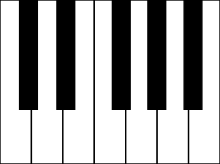Chromatic scale

The chromatic scale (or twelve-tone scale) is a set of twelve
Most music uses subsets of the chromatic scale such as diatonic scales. While the chromatic scale is fundamental in western music theory, it is seldom directly used in its entirety in musical compositions or improvisation.
Definition
The chromatic scale is a
In equal temperament, all the semitones have the same size (100 cents), and there are twelve semitones in an octave (1200 cents). As a result, the notes of an equal-tempered chromatic scale are equally-spaced.
The chromatic scale...is a series of half steps which comprises all the pitches of our [12-tone] equal-tempered system.
— Allen Forte (1979)[2]
All of the pitches in common use, considered together, constitute the chromatic scale. It is made up entirely of successive half steps, the smallest interval in Western music....Counting by half steps, an octave includes twelve different pitches, white and black keys together. The chromatic scale, then, is a collection of all the available pitches in order upward or downward, one octave's worth after another.
— Walter Piston (1987)[3]
A chromatic scale is a nondiatonic scale consisting entirely of half-step intervals. Since each tone of the scale is equidistant from the next [symmetry] it has no tonic [key].[4] ...
Chromaticism [is t]he introduction of some pitches of the chromatic scale into music that is basically diatonic in orientation, or music that is based on the chromatic scale instead of the diatonic scales.[5]— Benward & Saker (2003)
The ascending and descending chromatic scale is shown below.[4]


The twelve notes of the octave—all the black and white keys in one octave on the piano—form the chromatic scale. The tones of the chromatic scale (unlike those of the major or minor scale) are all the same distance apart, one half step. The word chromatic comes from the Greek chroma, color; and the traditional function of the chromatic scale is to color or embellish the tones of the major and minor scales. It does not define a key, but it gives a sense of motion and tension. It has long been used to evoke grief, loss, or sorrow. In the twentieth century it has also become independent of major and minor scales and is used as the basis for entire compositions.
— Roger Kamien (1976)[6]
Notation

The chromatic scale has no set
Similarly, some notes of the chromatic scale have enharmonic equivalents in
Pitch-rational tunings
Pythagorean
The most common conception of the chromatic scale before the 13th century was the
In Pythagorean tuning (i.e. 3-limit
C D♭ C♯ D E♭ D♯ E F G♭ F♯ G A♭ G♯ A B♭ A♯ B C Pitch
ratio1 256⁄243 2187⁄2048 9⁄8 32⁄27 19683⁄16384 81⁄64 4⁄3 1024⁄729 729⁄512 3⁄2 128⁄81 6561⁄4096 27⁄16 16⁄9 59049⁄32768 243⁄128 2 Cents 0 90.2 113.7 203.9 294.1 317.6 407.8 498 588.3 611.7 702 792.2 815.6 905.9 996.1 1019.6 1109.8 1200
where 256⁄243 is a diatonic semitone (
The chromatic scale in Pythagorean tuning can be tempered to the 17-EDO tuning (P5 = 10 steps = 705.88 cents).
Just intonation
In 5-limit just intonation the chromatic scale, Ptolemy's intense chromatic scale[citation needed], is as follows, with flats higher than their enharmonic sharps, and new notes between E–F and B–C (cents rounded to one decimal):
C C♯ D♭ D D♯ E♭ E E♯/F♭ F F♯ G♭ G G♯ A♭ A A♯ B♭ B B♯/C♭ C Pitch ratio 1 25⁄24 16⁄15 9⁄8 75⁄64 6⁄5 5⁄4 32⁄25 4⁄3 25⁄18 36⁄25 3⁄2 25⁄16 8⁄5 5⁄3 125⁄72 9⁄5 15⁄8 48⁄25 2 Cents 0 70.7 111.7 203.9 274.6 315.6 386.3 427.4 498 568.7 631.3 702 772.6 813.7 884.4 955 1017.6 1088.3 1129.3 1200
The fractions 9⁄8 and 10⁄9, 6⁄5 and 32⁄27, 5⁄4 and 81⁄64, 4⁄3 and 27⁄20, and many other pairs are interchangeable, as 81⁄80 (the syntonic comma) is tempered out.[clarification needed]
Just intonation tuning can be approximated by 19-EDO tuning (P5 = 11 steps = 694.74 cents).
Non-Western cultures
The ancient
See also
- Atonality
- Chromaticism
- Twelve-tone technique
- 20th century music#Classical
- "All Through the Night" (Cole Porter song)
Notes
- retrogradeto every other.
Sources
- ^ Jeans, James (1923). Science and Music. Cambridge University Press. pp. 24–25 – via Internet Archive.
- ^ ISBN 0-03-020756-8.
- ISBN 0-393-95480-3.
- ^ ISBN 978-0-07-294262-0.
- ^ Benward & Saker (2003). "Glossary", p. 359.
- ISBN 0-07-033568-0.
- JSTOR 2687250.
- ISBN 978-0-521-05802-5.
Further reading
- Hewitt, Michael. 2013. Musical Scales of the World. The Note Tree. ISBN 978-0957547001

![{\displaystyle {\sqrt[{12}]{2}}\approxeq 1.06}](https://wikimedia.org/api/rest_v1/media/math/render/svg/1241dd2aeab3b8ebf705cfe7d1ca86f0c07d905b)

